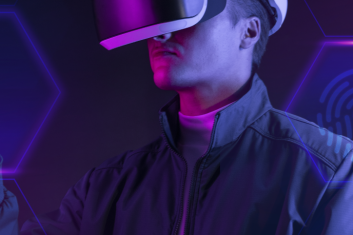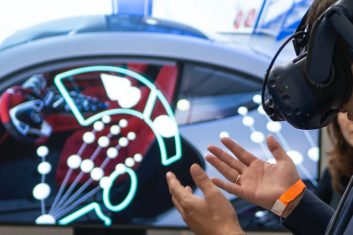In a world full of technology people have come up with the idea to create lifelike visual experiences. From panoramic paintings to immersive virtual realities we have gone a long way towards developing this technological vector.
This resulted in two impressive novelties: augmented and virtual reality.
Virtual reality is a simulated environment created by means of computer technology. People can experience virtual reality wearing headsets that provide a wide field of view. Designers, visual and sound artists, engineers, and programmers combine their knowledge and skills to create immersive environments. They make people believe they have visited another world.
Along with virtual reality, augmented reality is also a thing now. It is used when it is necessary to extend the real environment with “augmentations”: 3D or 2D virtual objects, buttons, sound. Visual objects often need a marker or real plane surface to be added on – a tabletop, floor and so on.
Want to develop an AR or VR solution?
Contact us now and get a free quote.
Anna Halias
Business Development Manager,
HQSoftware
Now AR and VR are extremely popular, so let’s follow the path of their development since the beginning.

1838
Charles Wheatstone invents the stereoscope. He discovered, that if you draw something from two slightly different perspectives and then view each picture through a different eye, you will see a 3D view. The stereoscope provided the viewer with such a possibility. This gadget paved the way for the technologies we use now: cinematography, photography and others.
1849
David Brewster enhances the stereoscope and thus invents a so-called “lenticular stereoscope”. He applies the results of his experiments and physical optics to create the first portable 3D viewer.
1901
L. Frank Baum publishes a novel where mentions an AR-like technology for the first time in history. “The Master Key: An Electrical Fairy Tale” is a novel about a teenage boy who is passionate about technologies and namely electricity. Once he summoned the Demon of Electricity, who gave him a gift – the “character marker”, a pair of glasses that revealed people’s hidden character flaws.
1929
Ed Link creates a flight simulator “Link Trainer”. This simulator allowed the pilots to obtain an accurate representation of how it really feels to control a plane thanks to the use of pumps, valves, and other appliances. This was a successful attempt of applying a prototype of virtual reality.
1935
Stanley G. Weinbaum mentions a pair of glasses that let the user experience virtual surroundings with the help of holographic images, smell, touch and taste in his novel “Pygmalion Spectacles”. As it has always been, science fiction predicted what we have now.
1939
William Gruber creates the View-Master – simple stereoscopic viewers that make you look at two identical pictures cross-eyed to see a unified 3D-image. View-Master was available for the consumer market and could be found in nearly every child’s bedroom.
1952
Morton Heilig invents Sensorama – the first VR-like machine with immersive multimodal technology that had a stereoscopic color display, emitters of odor, a sound system, and fans. Morton succeeded in drawing full viewer’s attention thanks to the Sensorama’s ability to engage users into a wide-angle stereoscopic image.
Business Value of AR in Media & Entertainment
How do modern businesses use AR to increase their revenues and outperform their industry competitors?

1960
Morton Heilig, again, invents the first head-mounted display. The patented Telesphere Mask provided the user with a stereoscopic 3D picture and stereo sound. Does it share a resemblance to VR gear?
1961
Comeau and Bryan develop Headsight. This wearable device tracked head movement and projected a screen for each eye. It had magnetic tracking options and a remote camera that corresponded with the head movement. There was no computer simulation, yet the device was partially similar to modern VR helmets.
1968
Ivan Sutherland and his student Bob Sproull invent The Sword of Damocles – another VR head-mounted display. Ivan was already known for his accomplishments in computer graphics development, and his experience aided him in developing this gadget. It displayed computer-generated wireframe rooms, and the perspective of the image depended on the head tracking data.
1969
Myron Krueger develops a set of computer-generated environments. They reacted to the people that acted inside of the environment. For example, the developed technology allowed people to communicate with each other remotely. He named this experience “artificial reality”.
1974
Myron Krueger builds an artificial reality lab Videoplace. His idea evolved from his experiments with virtual surroundings. Myron established the lab to allow people to communicate in “artificial reality” without gloves that would track movements and other appliances. At the Videoplace there were all the necessary hardware parts that allowed the user to be put on the simulated environment.
1982
Dan Reitan uses AR on television. Thanks to this man, AR gained mass adoption, and the following technology is being used even in present. Dan used cameras from space and radars to apply graphics to a weather broadcast. This interactive weather map was the first time for the people to see AR publicly.
1987
The name “virtual reality” is officially born thanks to Jaron Lanier. Earlier he founded VPL Research, and this company was the first one to sell VR products. It was also distributing specialized software that allowed to develop VR applications. The devices manufactured at VPL Research were pretty primitive: yet another head-mounted display the EyePhone, the DataGlove for data input, and even 3D image renderers and stereo sound simulators. Mattel later licensed the DataGlove to create Nintendo’s Power Glove, but it was not a success.
1990
Tom Caudell introduces the term “augmented reality”. He was working at Boeing and came up with an alternative to the diagrams that were used to guide field workers. He proposed to equip the workers with head-mounted wearables that would project the plane’s schematics on reusable boards. The displayed images could be easily edited with the help of a computer system.
In the 90s CAVE-style VR systems would win the market of VR and become a new norm. CAVEs are rooms where projectors are directed to the walls, creating an immersive virtual environment. Unfortunately, CAVEs caused headaches and motion sickness, and users did not want to receive that drawback.
1991
Virtuality Group creates VR arcade machines that can be found at video game centers. The machines boasted short response time and provided gamers with stereoscopic vision devices, game controllers, and the ability to cooperate in multiplayer games. In the 90s VR gaming was already powered with a bunch of hardware appliances, such as VR headsets, subsystems for graphics rendering, 3D trackers, exoskeleton-like wearable pieces. This trend is still ongoing.
1992
The Lawnmower Man the movie premiere. The plot was based on a fiction story of a scientist who used VR on a mentally ill patient. This was another example of how VR was becoming a natural part of the media entertainment industry.
Louis Rosenberg develops Virtual Fixtures. This AR system was developed in order to improve users’ capabilities to accomplish manipulative tasks. The system was developed at the U.S. Air Force Research Laboratory and was a classic AR overlay upon a user’s information perception. The system passed a Fitts Law performance testing and showed that such systems can significantly improve human performance in particular tasks.
1993
SEGA develops a VR headset. The version of it was intended to complement the Sega Genesis and Saturn consoles and arcades, but only the arcade one was released.
1994
Julie Martin creates the first-ever theatrical AR performance “Dancing in Cyberspace”. The dancers manipulated virtual objects and environments, creating an immersive image.
1995
Nintendo showcases its proprietary device VR-32 that will later be known as Virtual Boy. At the Consumer Electronics Show Nintendo claimed that their new device will give the players a stunning experience of interacting with the virtual reality. Virtual Boy was the first home VR device, and it was a great risk for the company – they launched the first-ever home VR product.
1996
The first-ever AR system with 2D markers CyberCode appears. It was based on the 2D-barcodes that could be recognized by even low-cost cameras that were installed in mobile devices. The system was able to determine the 2D position of the tagged object and has become a basis for a number of AR applications.
1998
Sportvision applies AR for the NFL game translation. The viewer’s experience was enhanced with the help of an AR overlay. There was a yellow first-down line smoothly painted on the field. It offered the viewers a guide to the state of play.
1999
The Matrix action film premiere. The Wachowskis, indeed, created a legendary movie that introduced the most thought-out virtual world to the viewers worldwide. The movie then united all the VR- and AR-like appliances and simulations possible, creating the foundation for the future creators.
1999
The first AR wearable device for soldiers BARS is released. Battlefield Augmented Reality System was intended to help soldiers improve visibility on the battlefield, communications, enemy location-identifying, and overall situational awareness.
NASA uses AR to navigate its X-38 spacecraft. The vehicle was equipped with an AR-powered dashboard for navigation.
Through time the technological field was developing, and since the millennium it was ready to offer more. For both the developers of VR and AR solutions and consumers the 21st century appeared to bring a wealth of opportunities.
2000
ARToolKit released. This was a revolutionary computer tracking library that allowed for creating AR applications. It is open-source and now hosted on GitHub.
A wearable device EyeTap is manufactured. EyeTap perceives the user’s eye as both a monitor and a camera and augments the world the user sees with computer-generated data.
The first mobile AR game ARQuaqe is released. It required a head-mounted display, a laptop that the user would carry in a backpack, a head movement tracker, a GPS system, and a connected plastic gun. This monstrous construction weighted 16 kg and obviously was not an example of convenient gaming.
2003
Sony releases the EyeToy for the PlayStation 2 – a digital camera for gesture recognition. The device allowed gamers to interact with games via body gestures, color recognition, and even sound – the device had a built-in microphone. EyeToy was not a commercial success, yet it introduced Sony to the VR market.
2007
Sony releases the PlayStation Eye. Despite EyeToy was not a successful project, Sony still decided to continue on the pace of device creation. The Eye focused on enhancing the experience in AR games. Later it will become a foundation for yet another Sony project.
2008
AR is used for advertising for the first time. BMW transformed a 2D ad in the magazine into a 3D model of their car Mini Cabrio. The readers needed to scan the image via a webcam to see the model of the car.
2009
FLARToolKit is released. Another helpful platform for the developers to create AR applications for the web appears.
For the past several years there were particular improvements in the field of AR and VR devices, but more is yet to come. The next years were the most flourishing for the AR and VR industries.
2010
Palmer Luckey introduces his first prototype of Oculus VR HMD. He announced a huge device that could display 2D images in a 90-degree vision and was so heavy that he even needed a counterweight in the back. Luckey decided that he needs to upgrade his gear and make it lightweight and more powerful.
2012
Palmer Luckey starts OculusVR and starts a project on Kickstarter to raise funds for his new headset Oculus Rift. Even John Carmack, lead programmer of Doom and Quake, and Valve’s Gabe Newell have backed the project. Within 3 days from the project start, it raised a million dollars. The Oculus Rift was a huge success and later the developers received the ability to create VR projects with the help of a development kit Oculus Rift DK1.
2012
Google announces its head-mounted optical display Google Glass. Yet the device was a huge step forward not only for the VR development but also for the IoT industry, some reviews were not warm. The early users expected a lot more than they got, so Google had a lot to upgrade and develop.
2013
Volkswagen uses AR for interactive service manuals. It helped with the critical data that service technicians needed the most – engine parts name and identification, where to turn the wrench and other.
2014
[emaillocker]
Sony announces Morpheus, a project that will later give birth to PlayStation VR. Morpheus was a virtual reality headset project for PlayStation 4. The engineers experimented with their own hardware, personal video viewers and PlayStation Move controllers to create a perfect prototype. They demonstrated it at the Game Developers Conference with a handful of game demos.
2015
AR and VR investments reach $700 million. More and more companies and even whole industries understood the value of these technologies and turn to their power.
2016
AR and VR investments reach $1.1 billion.
2016
Pokemon Go is released. It was probably the most popular AR game in the world, and one of the most profitable apps of 2016 – it earned $0.25 per active user daily.
2017
Google and Apple release its augmented reality frameworks. ARCore and ARKit provide developers with the most advanced AR development tools so that they can build realistic AR experiences.
[/emaillocker]
What else to come
The common prediction is that both AR and VR are on their path towards mainstream adoption, or the “Plateau of Productivity”, according to the Gartner Hype Cycle. The other predictions are:
- The implementation of AR and VR itself, wearable devices and compatible computers required to run AR and VR applications will become cheaper. This world of immersive realities will become more affordable for a significant amount of users.
- The amount of content that justifies buying a headset will increase.
- Development toolkits will become more feature-rich and available for a wider audience of developers.
- The success of AR and VR will depend on connectivity, faster processors and AI.
- The future goal of VR development is to create reactive content. This type of content demands using deep data gathering algorithms and learning biometric data about the user. Once the technology allows for collecting the information on emotions, rhythm, and preferences, the unique virtual story will be generated.
To sum up, we see a bright future for AR and VR to be applied for industrial purposes, advertising, entertainment and more. Now is the time when all the needed technologies are present, and all that remains is to develop it to its full extent.

Founder
Hey! Welcome to our blog!
The topics we cover include IoT, AR/VR, related news, and our projects.If you’d
like to discuss an article, please
messsage
me on LinkedIn






